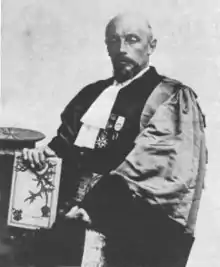Prosper-René Blondlot
Prosper-René Blondlot (3 July 1849 – 24 November 1930) was a French physicist, who in 1891 made the first measurement of the speed of radio waves, but is now mostly remembered for his "discovery" of N rays; a phenomenon that subsequently proved to be illusory.
Prosper-René Blondlot | |
|---|---|
 Circa 1910 photograph of Prosper-René Blondlot | |
| Born | 3 July 1849 |
| Died | 24 November 1930 |
Early life and work
Blondlot was born in Nancy, France, and spent most of his early years there, teaching physics at the University of Nancy, being awarded three prestigious prizes of the Académie des Sciences for his experimental work on the consequences of Maxwell's theory of electromagnetism.
In order to demonstrate that a Kerr cell responds to an applied electric field in a few tens of microseconds, Blondlot, in collaboration with Ernest-Adolphe Bichat, adapted the rotating-mirror method that Léon Foucault had applied to measure the speed of light. He further developed the rotating mirror to measure the speed of electricity in a conductor, photographing the sparks emitted from two conductors, one 1.8 km longer than the other and measuring the relative displacement of their images. He thus established that the speed of electricity in a conductor is very close to that of light.
In 1891, he made the first measurement of the speed of radio waves, by measuring the wavelength using Lecher lines.[1][2][3] He used 13 different frequencies between 10 and 30 MHz and obtained an average value of 297,600 km/s, which is within 1% of the current value for the speed of light.[1] This was an important confirmation of James Clerk Maxwell's theory that light was an electromagnetic wave like radio waves.
N Rays
In 1903, Blondlot announced that he had discovered N rays, a new species of radiation. The "discovery" attracted much attention over the following year and many physicists worked, unsuccessfully, to replicate the effects.
The French Academy of Sciences awarded the Prix Leconte (₣50,000) for 1904 to Blondlot, citing the totality of his work rather than the discovery of N-rays.[4]
American physicist Robert W. Wood, who had a reputation as a popular "debunker" of nonsense during the period, showed that the phenomena were purely subjective with no physical origin and by 1905, no one outside of Nancy believed in N rays; but Blondlot himself is reported to have still been convinced of their existence in 1926.[5]
The incident is now used as a cautionary tale among scientists on the dangers of error introduced by experimenter bias.
Later years
Little is known about Blondlot's later years. William Seabrook stated in his Wood biography Doctor Wood,[6] that Blondlot went insane and died, supposedly as a result of the exposure of the N ray debacle: "This tragic exposure eventually led to Blondlot's madness and death." Using an almost identical wording, this statement was repeated later by Martin Gardner: "Wood's exposure led to Blondlot's madness and death."[7] However, Blondlot continued to work as a university professor in Nancy until his early retirement in 1910.[8] He died at the age of 81; at the time of the N-ray affair, he was about 54–55 years old.
References
- "René Blondlot's Parallel Wires and Standing Waves". The Speed of Light. New Jersey Society for Amateur Scientists. 2002. Retrieved 2008-12-25., credited to K. D. Froome and L. Essen, "The Velocity of Light and Radio Waves", Academic Press, 1969
- "Length of Electric Waves". The Electrical Engineer. London: The Electrical Engineer, Ltd. 8: 482. November 20, 1891. Retrieved 2008-12-25.
- Deaton, Jennifer; Tina Patrick; David Askey (2002) [1996]. "History of the Speed of Light" (PDF). Junior Lab. Physics Dept. Univ. of Oklahoma. Retrieved 2008-12-25., p.15
- Gratzer, Walter Bruno (2000). The Undergrowth of Science: Delusion, Self-Deception and Human Frailty. Oxford: Oxford University Press. p. 11. ISBN 0-19-860435-1.
prix leconte blondlot.
- Lagemann, R.T. (1977). "New light on old rays: N rays". American Journal of Physics. 45 (3): 281–284. Bibcode:1977AmJPh..45..281L. doi:10.1119/1.10643.
- Seabrook William: Doctor Wood, Modern Wizard of the Laboratory Harcourt Brace, New York 1941
- Martin Gardner, Fads and Fallacies in the Name of Science (Popular Science); Dover Publications, 1957, ISBN 0-486-20394-8
- E. Pierret, Bull. Acad. Soc. Lorraines Sci. 7: 240 (1968)
External links
 Works written by or about Prosper-René Blondlot at Wikisource
Works written by or about Prosper-René Blondlot at Wikisource
